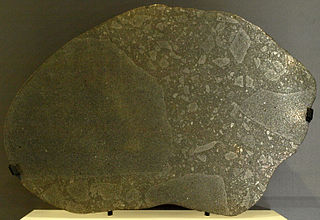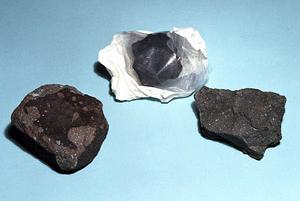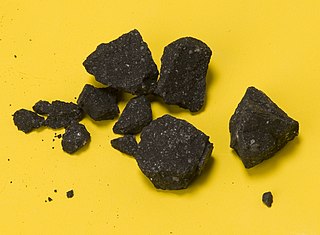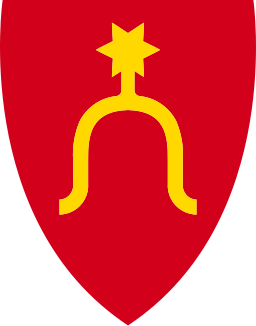
A Chondrule is a round grain found in a chondrite. Chondrules form as molten or partially molten droplets in space before being accreted to their parent asteroids. Because chondrites represent one of the oldest solid materials within the Solar System and are believed to be the building blocks of the planetary system, it follows that an understanding of the formation of chondrules is important to understand the initial development of the planetary system.

Chondrites are stony (non-metallic) meteorites that have not been modified due to melting or differentiation of the parent body. They are formed when various types of dust and small grains that were present in the early solar system accreted to form primitive asteroids. They are the most common type of meteorite that falls to Earth with estimates for the proportion of the total fall that they represent varying between 85.7% and 86.2%. Their study provides important clues for understanding the origin and age of the Solar System, the synthesis of organic compounds, the origin of life and the presence of water on Earth. One of their characteristics is the presence of chondrules, which are round grains formed by distinct minerals, that normally constitute between 20% and 80% of a chondrite by volume.

The H type ordinary chondrites are the most common type of meteorite, accounting for approximately 40% of all those catalogued, 46% of the ordinary chondrites, and 44% of the chondrites. The ordinary chondrites are thought to have originated from three parent asteroids, whose fragments make up the H chondrite, L chondrite and LL chondrite groups respectively.

The L type ordinary chondrites are the second most common group of meteorites, accounting for approximately 35% of all those catalogued, and 40% of the ordinary chondrites. The ordinary chondrites are thought to have originated from three parent asteroids, with the fragments making up the H chondrite, L chondrite and LL chondrite groups respectively.

The Tagish Lake meteorite fell at 16:43 UTC on 18 January 2000 in the Tagish Lake area in northwestern British Columbia, Canada.

The LL chondrites are a group of stony meteorites, the least abundant group of the ordinary chondrites, accounting for about 10–11% of observed ordinary-chondrite falls and 8–9% of all meteorite falls. The ordinary chondrites are thought to have originated from three parent asteroids, with the fragments making up the H chondrite, L chondrite and LL chondrite groups respectively. The composition of the Chelyabinsk meteor is that of a LL chondrite meteorite. The material makeup of Itokawa, the asteroid visited by the Hayabusa spacecraft which landed on it and brought particles back to Earth also proved to be type LL chondrite.
Meteorite fall statistics are frequently used by planetary scientists to approximate the true flux of meteorites on the Earth. Meteorite falls are those meteorites that are collected soon after being witnessed to fall, whereas meteorite finds are discovered at a later time. Although there are 30x more finds than falls, their raw distribution of types does not accurately reflect what falls to Earth. The reasons for this include:
- Some meteorite types are easier to find than others
- Some meteorite types are degraded by weathering more quickly than others
- Some meteorites, especially iron meteorites, may have been collected by people in the past who recognized them as being unusual and/or useful, thereby removing them from the scientific record
- Many meteorites fall as showers of many stones, but when they are collected long after the event it may be difficult to tell which ones were part of the same fall
- Many meteorites are found by people who sell meteorites... valuable, rare types become known to science quickly, while those of low value may never be described.

The Allende meteorite is the largest carbonaceous chondrite ever found on Earth. The fireball was witnessed at 01:05 on February 8, 1969, falling over the Mexican state of Chihuahua. After breaking up in the atmosphere, an extensive search for pieces was conducted and over 2 tonnes (tons) of meteorite were recovered. The availability of large quantities of samples of the scientifically-important chondrite class has enabled numerous investigations by a large number of scientists; it is often described as "the best-studied meteorite in history." The Allende meteorite has abundant, large calcium-aluminium-rich inclusions, which are among the oldest objects formed in the Solar System.

Pultusk is an H5 ordinary chondrite meteorite which fell on 30 January 1868 in Poland. The event has been known as the stony meteorite shower with the largest number of pieces yet recorded in history. Made up of rocky debris, it consists of pyroxene or olivine chondrules deployed in mass plagioclase, there being also kamacite.

Seymchan is a pallasite meteorite found in the dry bed of the river Hekandue, a left tributary of river Jasačnaja in the Magadan district, Russia, near the settlement of Seymchan, in June 1967.

Enstatite chondrites are a rare form of meteorite thought to comprise only about 2% of the chondrites that fall on Earth. Only about 200 E-Type chondrites are currently known.

CI chondrites, sometimes C1 chondrites, are a group of rare stony meteorites belonging to the carbonaceous chondrites. Samples have been discovered in France, Canada, India, and Tanzania. Compared to all the meteorites found so far, their chemical composition most closely resembles the elemental distribution in the sun's photosphere.

The Sutter's Mill meteorite is a carbonaceous chondrite which entered the Earth's atmosphere and broke up at about 07:51 Pacific time on April 22, 2012, with fragments landing in the United States. The name comes from the Sutter's Mill, a California Gold Rush site, near which some pieces were recovered. Meteor astronomer Peter Jenniskens assigned SM numbers to each meteorite, with the documented find location preserving information about where a given meteorite was located in the impacting meteoroid. As of May 2014, 79 fragments had been publicly documented with a find location. The largest (SM53) weighs 205 grams (7.2 oz), and the second largest (SM50) weighs 42 grams (1.5 oz).
This is a glossary of terms used in meteoritics, the science of meteorites.
The Ornans meteorite is a carbonaceous chondrite and the type specimen of the CO group. Its fall was observed in France in 1868.
Mason Gully is an ordinary chondrite of subclass H5, and is the second meteorite to be recovered using the Desert Fireball Network (DFN) camera observatory. One stone weighing 24.5g was observed to fall by the Desert Fireball Network observatory in Western Australia on 13 April 2010 at 10h36m10s UTC. It was recovered by the DFN on 3 November 2010, and was found 150m from its predicted fall location based upon the observed trajectory and calculated mass.
























